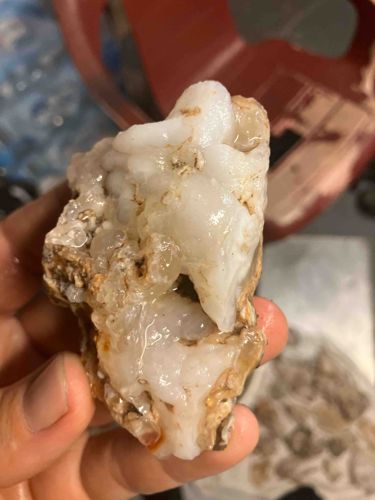
Botryoidal Chalcedony or Agate Specimen
This appears to be a raw mineral specimen, likely a type of Chalcedony or Agate. The overall form is irregular and natural, showcasing botryoidal or mammillary growth patterns, characterized by rounded, globular masses. The color is predominantly milky white to translucent, with areas exhibiting a slightly yellowish or tan hue, particularly where the rock matrix is still attached. The surface is irregular and varies in texture, with some areas appearing smooth and glossy, indicative of crystalline growth, while others are rough and unrefined. There are visible inclusions or veins of different colored material, possibly iron staining or other minerals within the matrix. The piece is relatively small, held in a hand, giving a sense of its size. There are no discernible manufacturing marks, signatures, or stamps, as this is a natural, raw material. The condition appears to be as-found with evidence of some minor chipping or naturally occurring fractures along the edges. The quality is that of a natural specimen, valued for its geological formation and aesthetic appeal rather than craftsmanship.
AI-Generated Appraisal Disclaimer
Estimated Value
$30-50
Basic Information
Category
Mineral Specimen
Appraised On
December 14, 2025
Estimated Value
$30-50
Item Description
This appears to be a raw mineral specimen, likely a type of Chalcedony or Agate. The overall form is irregular and natural, showcasing botryoidal or mammillary growth patterns, characterized by rounded, globular masses. The color is predominantly milky white to translucent, with areas exhibiting a slightly yellowish or tan hue, particularly where the rock matrix is still attached. The surface is irregular and varies in texture, with some areas appearing smooth and glossy, indicative of crystalline growth, while others are rough and unrefined. There are visible inclusions or veins of different colored material, possibly iron staining or other minerals within the matrix. The piece is relatively small, held in a hand, giving a sense of its size. There are no discernible manufacturing marks, signatures, or stamps, as this is a natural, raw material. The condition appears to be as-found with evidence of some minor chipping or naturally occurring fractures along the edges. The quality is that of a natural specimen, valued for its geological formation and aesthetic appeal rather than craftsmanship.
Related Tags
Get Your Items Appraised
Instant estimates of your treasures with AI-powered instant appraisals